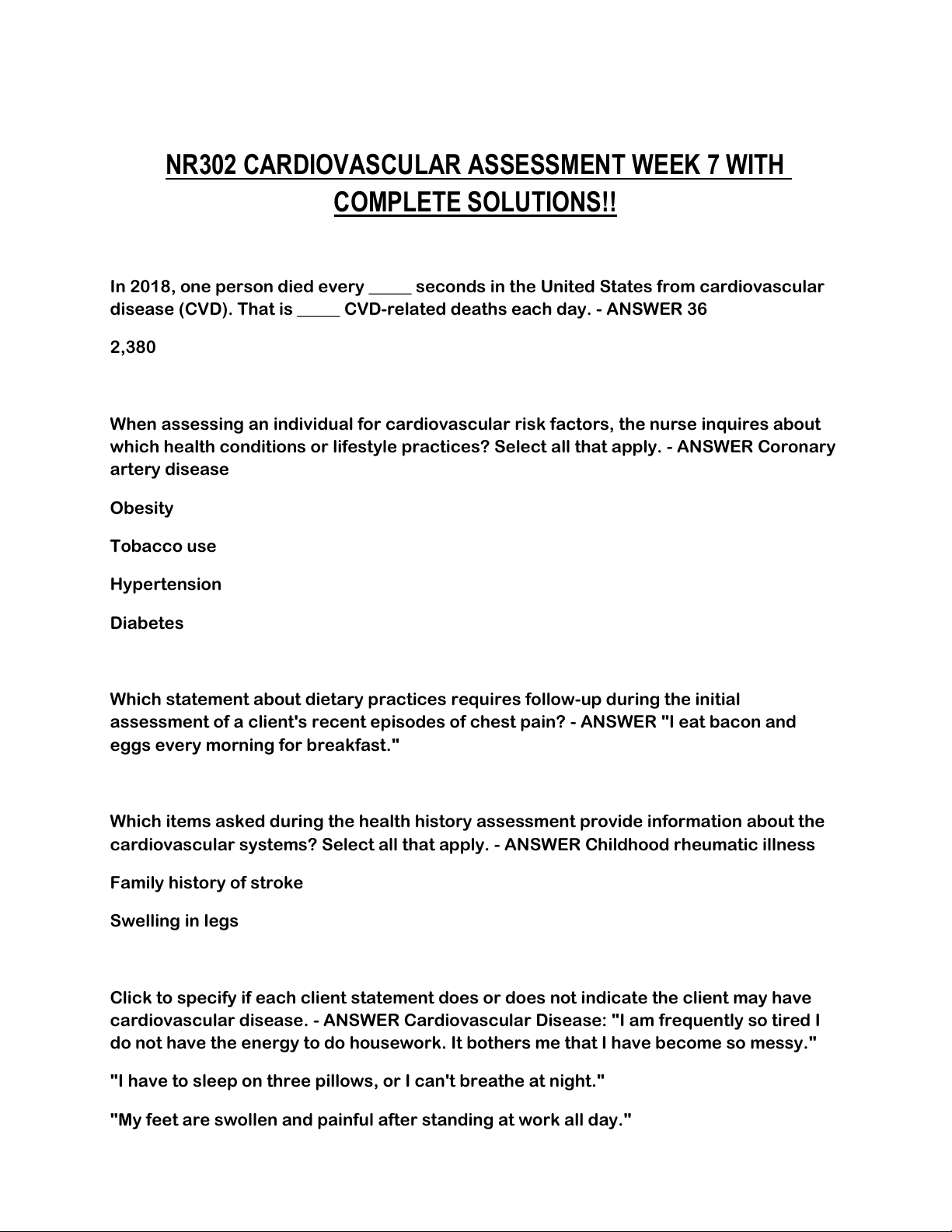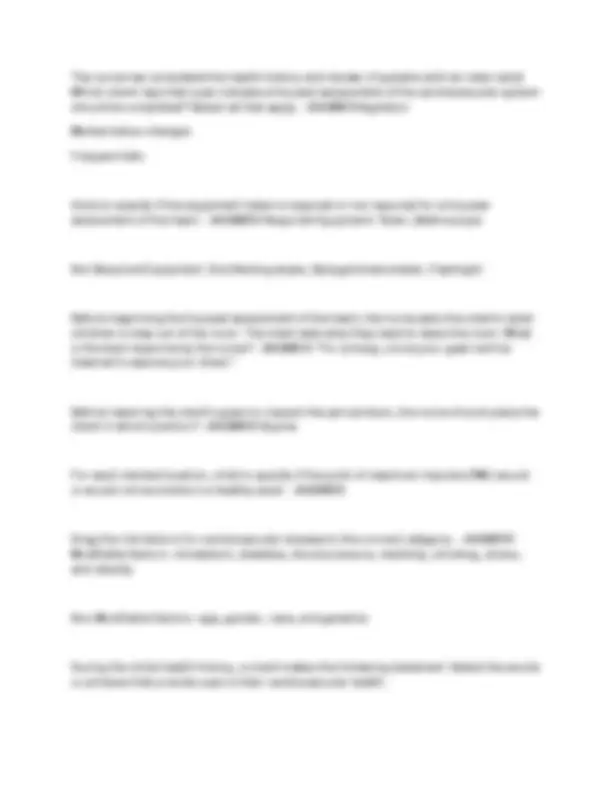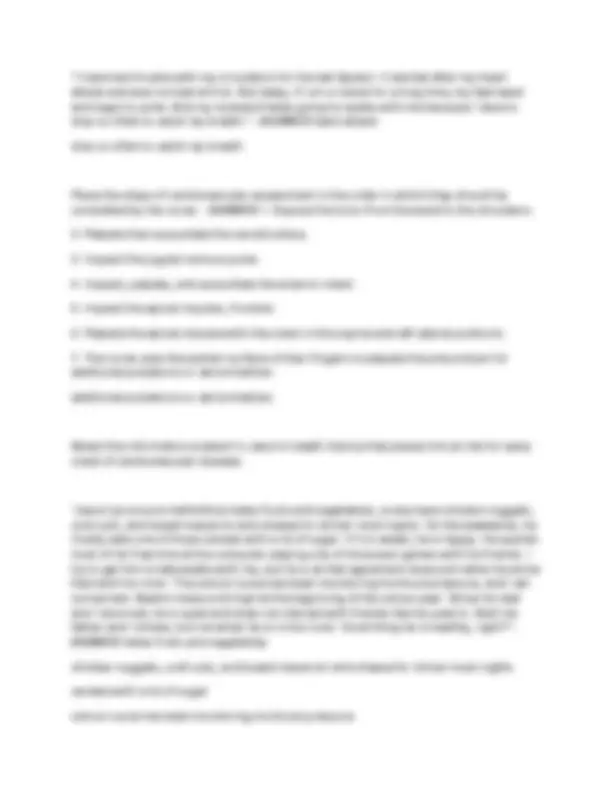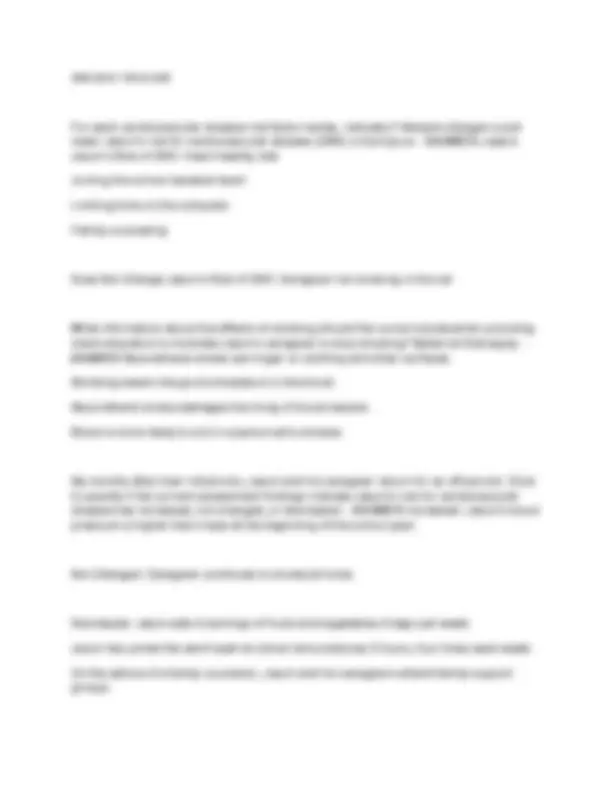






Study with the several resources on Docsity

Earn points by helping other students or get them with a premium plan


Prepare for your exams
Study with the several resources on Docsity

Earn points to download
Earn points by helping other students or get them with a premium plan
Community
Ask the community for help and clear up your study doubts
Discover the best universities in your country according to Docsity users
Free resources
Download our free guides on studying techniques, anxiety management strategies, and thesis advice from Docsity tutors
NR302 CARDIOVASCULAR ASSESSMENT WEEK 7 WITH COMPLETE SOLUTIONS!!
Typology: Exams
1 / 8

This page cannot be seen from the preview
Don't miss anything!





In 2018, one person died every _____ seconds in the United States from cardiovascular disease (CVD). That is _____ CVD-related deaths each day. - ANSWER 36
2,
When assessing an individual for cardiovascular risk factors, the nurse inquires about which health conditions or lifestyle practices? Select all that apply. - ANSWER Coronary artery disease
Obesity
Tobacco use
Hypertension
Diabetes
Which statement about dietary practices requires follow-up during the initial assessment of a client's recent episodes of chest pain? - ANSWER "I eat bacon and eggs every morning for breakfast."
Which items asked during the health history assessment provide information about the cardiovascular systems? Select all that apply. - ANSWER Childhood rheumatic illness
Family history of stroke
Swelling in legs
Click to specify if each client statement does or does not indicate the client may have cardiovascular disease. - ANSWER Cardiovascular Disease: "I am frequently so tired I do not have the energy to do housework. It bothers me that I have become so messy."
"I have to sleep on three pillows, or I can't breathe at night."
"My feet are swollen and painful after standing at work all day."
No Cardiovascular Disease: "My sister's neighbor was just diagnosed with high blood pressure and aortic stenosis. Now she thinks I have it because I am the same age as her neighbor."
"I have become a better swimmer now that I spend thirty minutes every other day exercising in the pool."
"Shopping at the local farmers' market has been good for my weight and my budget."
The examiner inspects the chest wall for ________ , palpates the chest wall to identify the correct location for _______, and uses the diaphragm and bell of the ______ to assess the heart rate, rhythm, and sounds. - ANSWER visual pulsations
Cardiac auscultation
Stethoscope
On the image, use the dropdown menu to identify the heart sound best heard at each circled location. - ANSWER
Which abnormal heart sound is caused by one or more of the valves not opening or closing correctly? - ANSWER Murmur
While assessing a client with a murmur of the pulmonic valve, the nurse places the stethoscope at the ______ intercostal space at the ________. - ANSWER 2nd
left sternal border
Indicate the heart sound best heard in each auscultatory area using the drop-down list. - ANSWER
A client with no history of cardiovascular disease comes into the ambulatory clinic with flu-like symptoms. The client suddenly complains of chest pain. Which question would best help a nurse determine the most likely source of the client's chest pain? - ANSWER "Does the pain get worse when you breathe in?"
"I have had trouble with my circulation for the last 5years. It started after my heart attack and was not bad at first. But lately, if I sit or stand for a long time, my feet swell and begin to ache. And my husband hates going for walks with me because I have to stop so often to catch my breath." - ANSWER heart attack
stop so often to catch my breath
Place the steps of cardiovascular assessment in the order in which they should be completed by the nurse. - ANSWER 1. Expose the torso from the waist to the shoulders.
additional pulsations or abnormalities.
Select the information present in Jason's health history that places him at risk for early onset of cardiovascular disease.
"Jason (pronouns he/him/his) hates fruits and vegetables, so we have chicken nuggets, cold cuts, and boxed macaroni and cheese for dinner most nights. On the weekends, he mostly eats one of those cereals with a lot of sugar. If it is sweet, he is happy. He spends most of his free time at the computer playing one of those war games with his friends. I try to get him to take walks with me, but he is at that age where he would rather be alone than with his mom. The school nurse has been monitoring his blood pressure, and I am concerned. Seems it was a bit high at the beginning of the school year. Since his dad and I divorced, he is quiet and does not interact with friends like he used to. Both his father and I smoke, but not when he is in the room. Good thing he is healthy, right?" - ANSWER hates fruits and vegetables
chicken nuggets, cold cuts, and boxed macaroni and cheese for dinner most nights
cereals with a lot of sugar
school nurse has been monitoring his blood pressure
dad and I divorced
For each cardiovascular disease risk factor below, indicate if lifestyle changes could lower Jason's risk for cardiovascular disease (CVD) in the future. - ANSWER Lowers Jason's Risk of CVD: Heart healthy diet
Joining the school baseball team
Limiting time on the computer
Family counseling
Does Not Change Jason's Risk of CVD: Caregiver not smoking in the car
What information about the effects of smoking should the nurse include when providing client education to motivate Jason's caregiver to stop smoking? Select all that apply. - ANSWER Secondhand smoke can linger on clothing and other surfaces.
Smoking lowers the good cholesterol in the blood.
Secondhand smoke damages the lining of blood vessels.
Blood is more likely to clot in a person who smokes.
Six months after their initial visit, Jason and his caregiver return for an office visit. Click to specify if the current assessment findings indicate Jason's risk for cardiovascular disease has increased, not changed, or decreased. - ANSWER Increased: Jason's blood pressure is higher than it was at the beginning of the school year.
Not Changed: Caregiver continues to smoke at home.
Decreased: Jason eats 6 servings of fruits and vegetables 6 days per week.
Jason has joined the swim team at school and practices 2 hours, four times each week.
On the advice of a family counselor, Jason and his caregivers attend family support groups.
An older adult male presents to the emergency department with crushing chest pain that radiates to the left shoulder and left arm.
Which question should the nurse ask first? - ANSWER "When did the pain start?"
The client states that the chest pain started suddenly about 45 minutes prior to arrival. Which three questions should the nurse ask next? Select all that apply. - ANSWER "Where did the pain start?"
"What were you doing when the pain started?"
"Have you had this type of pain before?"
For each description of pain, indicate if the pain is associated with angina pectoris, myocardial infarction, gastroesophageal reflux disease (GERD), or pneumothorax. - ANSWER Angina Pectoris: Heavy, squeezing, lasts 3-5 minutes
Myocardial Infarction: Viselike, crushing, poorly localized
Substernal indigestion-like feeling
GERD: Burning behind the sternum
Pneumothorax: Sudden, sharp, radiates to the shoulder
Based on the assessment, the nurse concludes that the client is most likely experiencing ______ and plans to immediately ______. - ANSWER A myocardial infarction
Notify the healthcare provider
After evaluating the client, the healthcare provider determines they are experiencing a myocardial infarction and orders tests and medications. An hour after administering the ordered medications, the nurse reassesses the client. Indicate if the assessment data indicates if the client's status has improved, declined, or if there is not enough data to
determine. - ANSWER Improved: Achy, substernal pain
No pain in shoulders or arms
Declined: Nausea and vomiting
Not Enough Data: Resting quietly